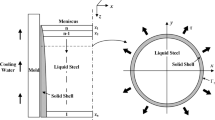Abstract
Numerical methods to improve the computational efficiency and to extend the computational scale of the mold filling and solidification of the aluminum die casting process were studied. For molding filling simulation, the parallel computation method was studied, while for solidification simulation, an implicit finite difference scheme and a transient surface layer concept were studied. In addition, the modified cellular automaton method was used to simulate the microstructure formation and evolution of the aluminum alloy, including the grain structure and the dendritic microstructure. The experimental results show that the models in the article are reasonable for describing the formation and evolution of the microstructure formation.










Similar content being viewed by others
Abbreviations
- C L :
-
species mass fraction in liquid (pct)
- C S :
-
species mass fraction in solid (pct)
- c :
-
specific heat (J·kg−1·K−1)
- D L :
-
species diffusion coefficient in liquid (m2·s−1)
- D S :
-
species diffusion coefficient in solid (m2·s−1)
- d :
-
thickness of transient layer, in grid number (m)
- f L :
-
mass fraction of liquid (pct)
- f s :
-
mass fraction of solid (pct)
- k :
-
turbulent kinetic energy (J)
- L :
-
latent heat (J·kg−1)
- N :
-
total grid number
- N :
-
grain density (m−3)
- N 0 :
-
grid number in transient area
- N max :
-
maximum nucleus density (m−3)
- \( \mathop{Q}\limits^{\bullet}\) :
-
latent heat release rate of solidification (J/s)
- S \( _{\phi}\) :
-
source term
- T :
-
temperature (K)
- t :
-
time (s)
- T 1, T 2 :
-
average surface temperature of the die and the casting (K)
- t c :
-
cycle time of the process (s)
- t cal :
-
calculation time of the solidification process (s)
- ΔT :
-
undercooling (K)
- ΔT N :
-
mean nucleation undercooling (K)
- ΔT σ :
-
standard deviation of distribution (K)
- Δt s :
-
time-step in steady area, times of the transient area (s)
- u j :
-
velocity in the x j coordinate direction (m·s−1)
- v :
-
interface moving velocity (m·s−1)
- x j :
-
coordinate component (m)
- x, y, z :
-
coordinates (m)
- α :
-
thermal diffusivity of the die material (m2/s)
- \( \phi \) :
-
represents the field variable for any time-averaged quantities, such as mean velocities (u j ), turbulent kinetic energy (k), turbulent energy dissipation rate (ε), and temperature (T)
- λ :
-
thermal conductivity (W·m−1·K−1)
- ρ :
-
density (kg/m3)
- ε :
-
turbulent energy dissipation rate
- \( \Gamma _{\phi } \) :
-
represents the diffusivity of the transported variable \( \phi \)
- * :
-
solid/liquid interface
References
L. Jia, S. Xiong, and B. Liu: J. Mater. Sci. Technol., 2000, vol. 16 (3), pp. 269–72
M. Rappaz: Int. Mater. Rev., 1989, vol. 34 (3), pp. 93–123
W.-J. Rappel and A. Karma: J. Cryst. Growth, 1997, vol. 174, pp. 54–64
J.A. Spittle and S.G.R. Brown: Acta Metall., 1989, vol. 37, pp. 1803–10
M. Rappaz and C.-A. Gandin: Acta Metall. Mater., 1994, vol. 41, pp. 345–60
G. Wang, S. Xiong, B. Liu, and S. Li: Int. J. Cast. Met. Res., 2002, vol. 15 (3), pp. 143–47
G. Wang, S. Xiong, and B. Liu: Proc. 6th Pacific Rim Int. Conf. on Modeling of Casting and Solidification Processes, H. Weng-Sing, ed., Metal Industries Research and Development Centre, Kaohsiung, Taiwan, Aug. 8–11, 2004, pp. 429–36
M.R. Barone and D.A. Caulk: J. Heat Transfer, 1993, vol. 115 (2), pp. 284–93
S.M. Xiong, F. Lau, and W.B. Lee: J. Mater. Process. Technol., 2002, vol. 128 (1–3), pp. 19–24
Acknowledgments
This research was supported by the National Basic Research Program of China (Grant No. 2005CB724105) and the NSFC (Grant No. 10477010).
Author information
Authors and Affiliations
Corresponding author
Additional information
This article is based on a presentation made in the symposium entitled “Simulation of Aluminum Shape Casting Processing: From Design to Mechanical Properties,” which occurred March 12–16, 2006 during the TMS Spring Meeting in San Antonio, Texas, under the auspices of the Computational Materials Science and Engineering Committee, the Process Modeling, Analysis and Control Committee, the Solidification Committee, the Mechanical Behavior of Materials Committee, and the Light Metal Division/Aluminum Committee.
Rights and permissions
About this article
Cite this article
Liu, B., Xiong, S. & Xu, Q. Study on Macro- and Micromodeling of the Solidification Process of Aluminum Shape Casting. Metall Mater Trans B 38, 525–532 (2007). https://doi.org/10.1007/s11663-007-9073-y
Published:
Issue Date:
DOI: https://doi.org/10.1007/s11663-007-9073-y




